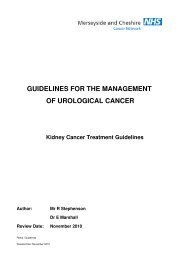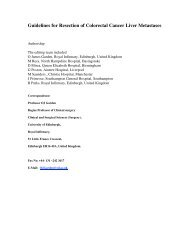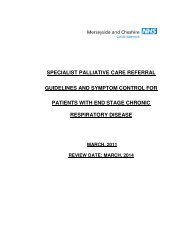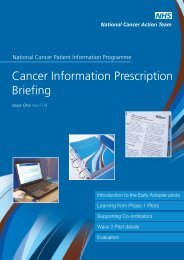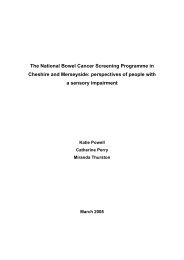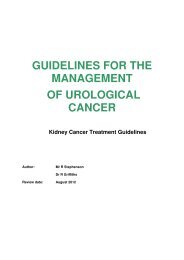Cancer Reform Strategy - NHS Cancer Screening Programmes
Cancer Reform Strategy - NHS Cancer Screening Programmes
Cancer Reform Strategy - NHS Cancer Screening Programmes
- No tags were found...
Create successful ePaper yourself
Turn your PDF publications into a flip-book with our unique Google optimized e-Paper software.
60 CANCER REFORM STRATEGY●Identify suitable surgeons (and theirsupporting teams) to receive nationaltraining and release them for thistraining;●There is currently a 2.5 fold variation inradiotherapy activity between cancernetworks, which cannot be attributed todifferences in levels of need;●●●Allow some surgeons to become“laparoscopic colorectal surgery trainers”as part of the national programme;Put the necessary facilities andequipment in place to providelaparoscopic colorectal surgery; andStart to offer the option of laparoscopiccolorectal surgery to patients as soon asthey have the necessary capacity andexpertise in place to do so and byDecember 2009 at the latest.Radiotherapy4.22 Radiotherapy has an important role in thetreatment of many different forms of cancer.For some cancers radiotherapy may be the mainform of treatment, such as for cancer of thelarynx, where preserving the voice-box may be ahigh priority. For other cancers, radiotherapymay be used alongside surgery, for example inbreast conserving procedures for breast cancer,or alongside chemotherapy such as foroesophageal cancer. Radiotherapy is alsoextensively used to alleviate symptoms ofadvanced cancer, such as pain from bonemetastases. Experts estimate that at least half ofall cancer patients require radiotherapy at somepoint in their care pathway.4.23 The National Radiotherapy Advisory Group(NRAG) has submitted a report to Ministersentitled “Radiotherapy: developing a world classservice for England”. Key findings from thisreport, which was published in May 2007, are asfollows:●●The need for radiotherapy wasunderestimated in the past;Demand is set to grow over the next tenyears;●●●●On average around 30,000 fractions arecurrently being delivered per millionpopulation, with a range of 17,000 to48,000 fractions per million betweennetworks;By 2016 it is estimated that there will be aneed for around 54,000 fractions per millionpopulation, requiring more staff and linearaccelerator machines (linacs);The <strong>NHS</strong> needs to make best use of existingstaff and equipment. Across a radiotherapydepartment an average output of 8000fractions per linac (radiotherapy machine) perannum should be achievable immediately,working towards at least 8,700 fractions by2016; andThere is a clear need to collect better data onradiotherapy activity.4.24 To achieve a world class radiotherapyservice local investment will be neededboth in equipment and workforce. Most(85%) radiotherapy is given as a second or thirdtreatment after surgery and/or chemotherapy, orat the recurrence of cancer. If <strong>NHS</strong> Trusts areto meet the new extension to the 31 daystandard, increased capacity in radiotherapywill be urgently needed.Radiotherapy facilities4.25 Following the publication of the <strong>NHS</strong><strong>Cancer</strong> Plan, over £500 million was invested inadditional and replacement equipment forcancer, including 167 new linacs (October 2007figures) for radiotherapy.4.26 Despite this, the average number of linacsper million population is still below manyEuropean countries. A 2005 report from theESTRO QUARTS project which compared thenumbers of megavoltage therapy units (linacsand cobalt units) per million population forseveral European countries including England




